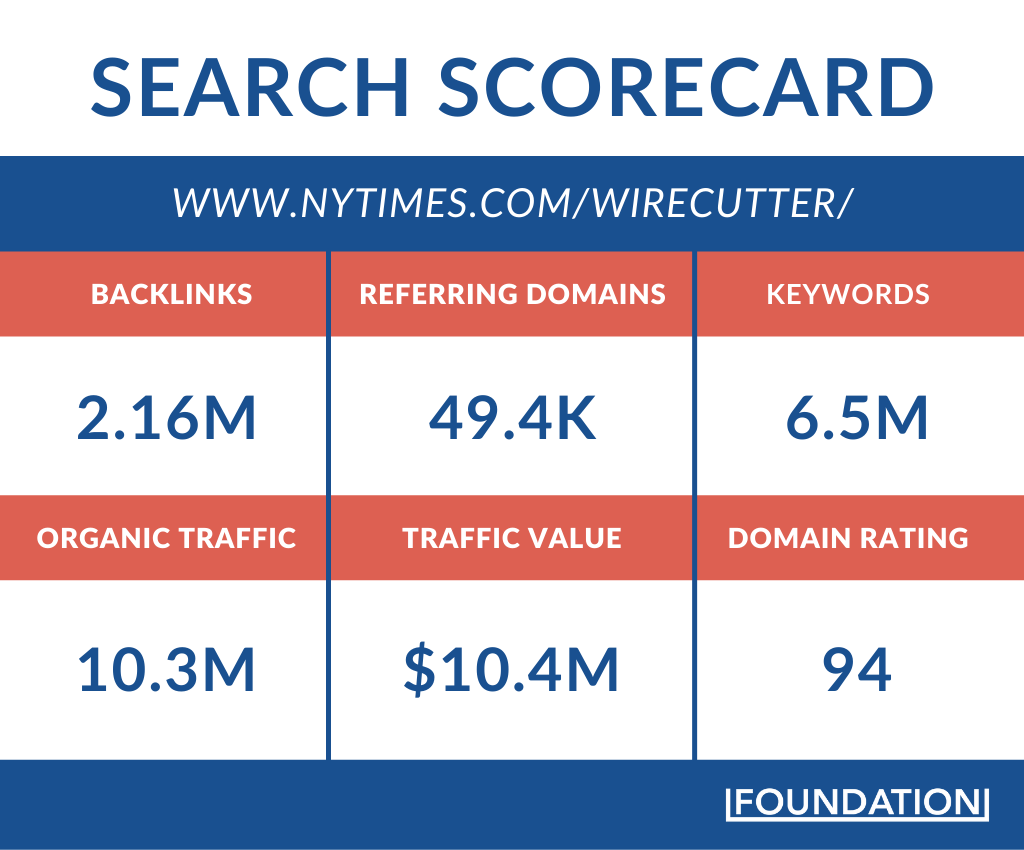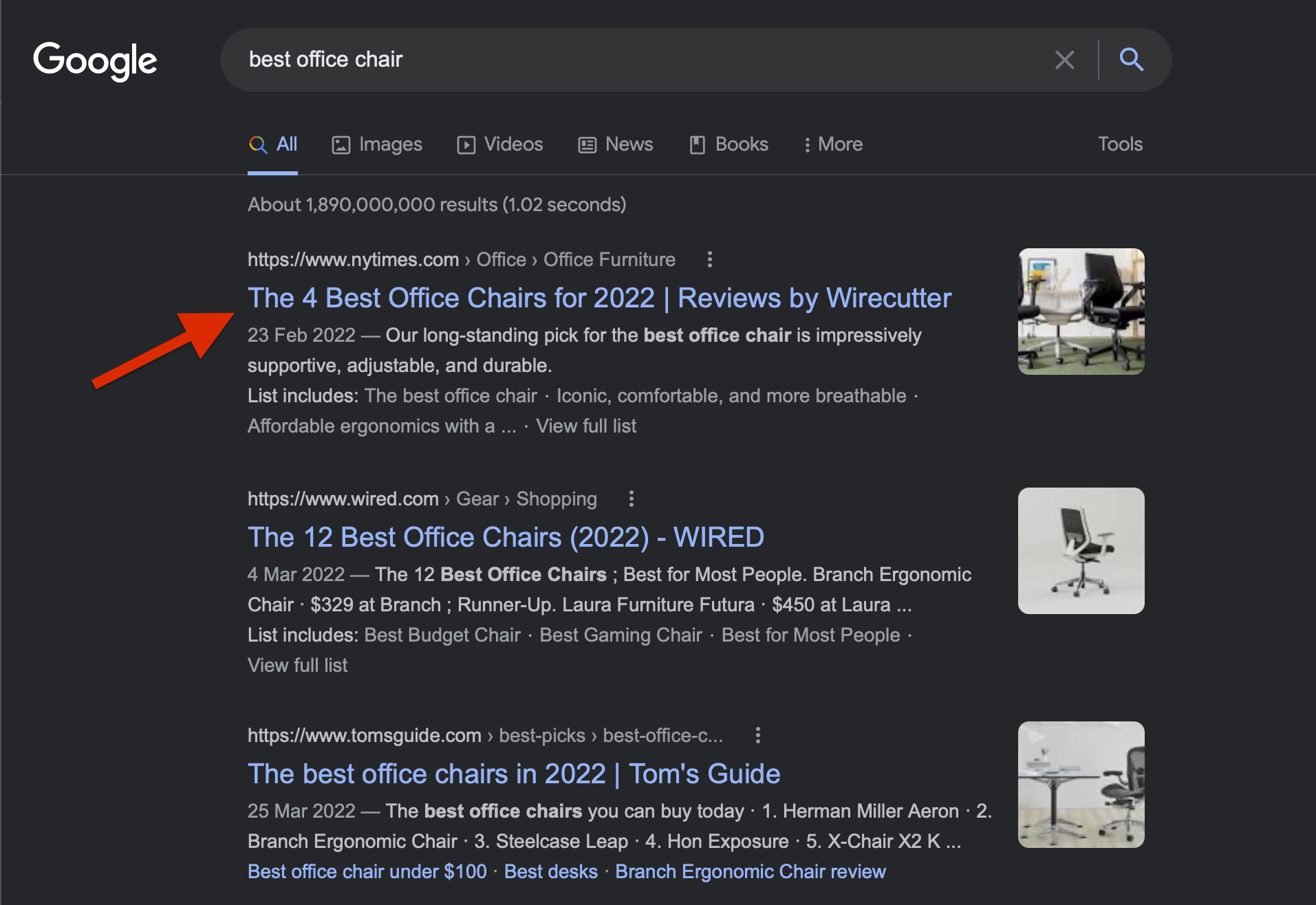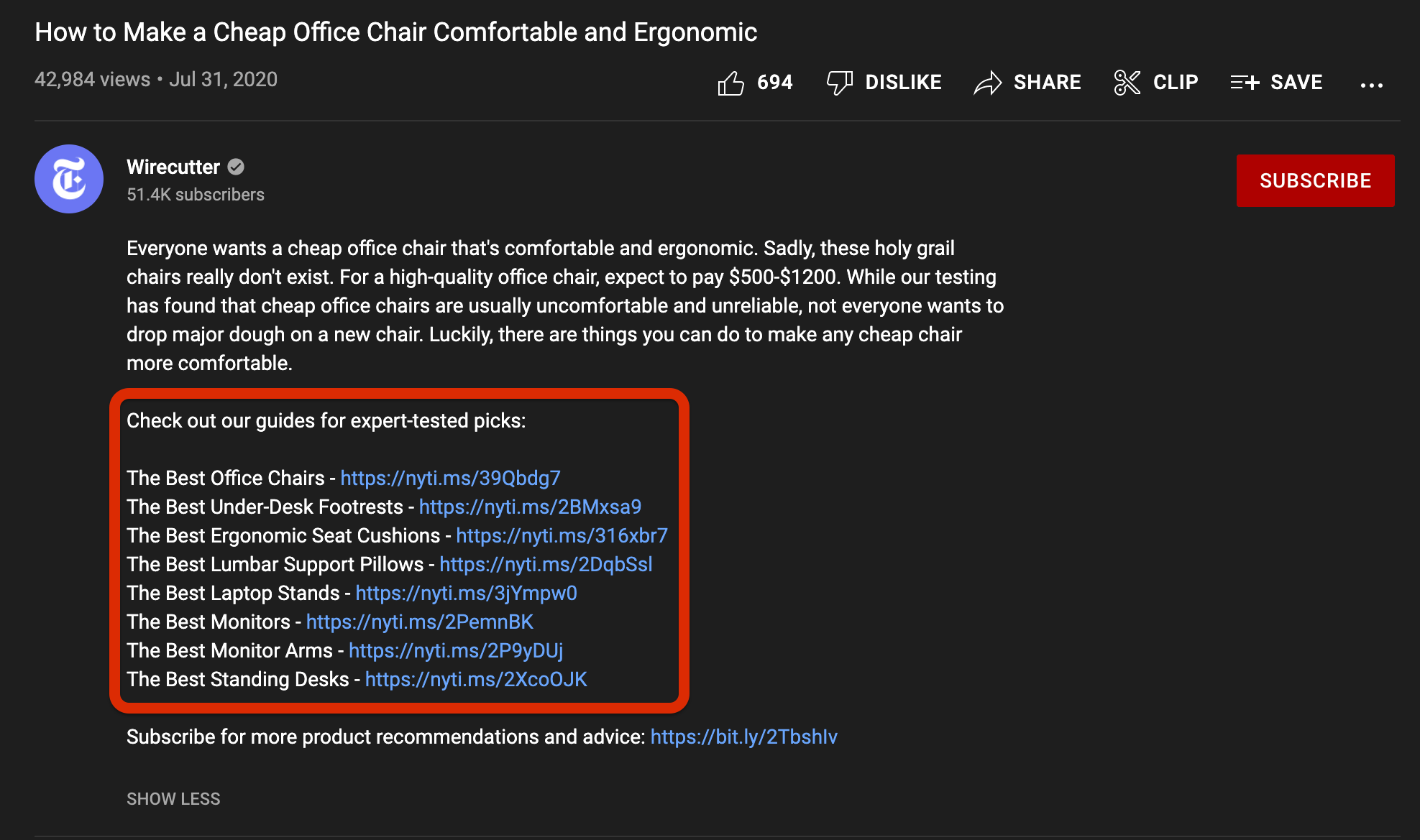Article's Content
It’s not every day you hear news of a product review website selling for $30 million. Yet, that’s how much The New York Times paid for Wirecutter in 2016.
What made The New York Times make such a considerable investment in a site that reviews products?
For starters, Wirecutter tested and reviewed thousands of products from different categories.
Whether it’s headphones…

Or furniture…

Or baby and kid stuff…

Wirecutter reviews anything and everything. And this was something The New York Times wanted to implement across their organization.
These reviews also attract a more-than-decent number of people to the Wirecutter website. Let’s look at the numbers:
- Ranking for over 6 million keywords
- Attracting over 10 million in organic traffic
- A $10.4M traffic value
Here’s a look at their search scorecard.

Impressive, isn’t it?
Even more impressive is that the site isn’t just generating traffic for traffic’s sake. On the contrary, the Wirecutter website contributes to over $150 million in sales, with the site making around 6-10% in affiliate commissions.
This analysis shows how Wirecutter accomplished it all. As you read, you’ll learn how Wirecutter:
- Creates content that builds its website’s E-A-T factor
- Uses opinionated content to stand out
- Makes its product reviews to build authority
- Matches search intent to dominate the SERP
Let’s dive in.
[memberful_sign_in_link]Sign in to your account.[/memberful_sign_in_link]
How Wirecutter Sends the Right Signals to Google’s E-A-T Algorithm
E-A-T stands for Expertise, Authoritativeness, and Trustworthiness.
And it is an essential guideline Google uses to determine whether a piece of content and its creators are of high-enough quality to provide value to readers and thus rank.
Although all websites that aim to rank need to pay attention to Google E-A-T, it’s especially more important for YMYL (Your Money or Your Life) sites — that cover financial, health, and legal issues.
Wirecutter falls into the YMYL site category considering that people visit it when looking for products to spend their hard-earned money on.
So how does Wirecutter ensure its content keeps up with E-A-T standards and remains of high authority?
Let’s find out.
Building E-A-T by Sharing Expert Opinions
One of the most significant differences between Wirecutter and the hundreds of other review websites is that Wirecutter offers an opinion concerning what product its reader should buy.
Here’s why doing so makes sense.
Imagine that you were one of the thousands who Googled “best office chair” at the start of the pandemic as you were trying to set up your home office.
You’ve never bought an office chair before, so it’s not surprising that you don’t know anything about them — other than you need one.
When Google returns the search query, you find yourself looking at ten results that contain a list of chairs to choose from.

As you click each link, you discover most of them contain a listicle where all the 7, 10, or 12 chairs are the best.
Since you can’t buy ten chairs, these review sites leave you where you started — still confused about what chair to buy for your home office.
However, unlike the rest of the review sites, Wirecutter tells you that the Steelcase Gesture is the best office chair you can buy.
While it might look like they’re sidelining other products, sharing an opinion about what they consider best — through actual testing — makes Wirecutter’s reviews beneficial to its readers.
By singling out a specific product, Wirecutter has already decided for their reader.
However, how do readers know they can trust Wirecutter’s opinion?
They do, thanks to how Wirecutter’s team writes their reviews and tests products.
Working with Experts
A lot goes into creating review guides at Wirecutter.
For instance, their guide about the best office chairs is over 10K words. While the piece about the best robot vacuums is just under 17K words.
That’s a lot of words, especially considering that SEO and content marketing experts recommend a word length of around 2K-3K words.
Unlike articles stuffed with words just to make them longer, every single word on a Wirecutter review counts.
Wirecutter doesn’t just hire freelance writers to meet a word count. Instead, the writers they use have first-hand experience or subject matter expertise around the products they’re writing about.
For instance, Tim Heffernan, who wrote the best air purifier guide, spent years using these air purifiers in his New York apartment to gather objective data and make informed judgments.
The same goes for the other Wirecutter reviews.
So what happens if the writer doesn’t have first-hand experience with the product? In cases like that, Wirecutter sources outside voices who understand the product’s ins and outs.
For example, when writing the best office chair guide, the Wirecutter team reached out to and interviewed people like Professor Alan Hedge, Rani Lueder, and Jenny Pynt, who had a ton of experience with ergonomics and office chairs, to help improve the piece.
Undoubtedly, making their content more trustworthy is a positive sign to search engines, especially Google, to rank their content higher than other results.
Clarifying the Purpose of Their Content
Aside from identifying the experts creating an article, Wirecutter also uses its content to further draw out the pain points of anyone looking for this product.
Doing so helps Wirecutter create reviews that resonate with their audience.
In addition, they also quickly call out those who the product might help and those who wouldn’t benefit as much from buying the product they’re reviewing.
For example, the review for the best office chairs specifically mentions that the guide is for “those who work full-time from their office chair,” and not for people who don’t spend more than six hours at a desk.
This sort of transparency undoubtedly goes a long way in helping Wirecutter build trust with Google and its target audience and shows that they’re not all about the referral income they might generate.
Updating Content Regularly
Humans are expected to produce over 463 billion GB of data daily by 2025. This enormous data output and consumption means that many pieces of content live a short life. And, as such, need to be updated regularly.
In the review industry, where old products get updates and new ones are introduced, brands must keep their content accurate so readers can get the most value from them.
Wirecutter understands this need, and that’s why they update their content to give readers the best review they can get about different products.

As a marketer, you should also consider updating your content if it’s old or when it becomes irrelevant.
Creating Author Bios
Another vital thing the team at Wirecutter did to build their E-A-T is by using author bios in all their reviews.
The author bio, usually taking a small portion of the article, contains information about the review’s author and is excellent “real estate” to showcase expertise, authoritativeness, and trustworthiness.
Here’s what a typical Wirecutter author bio looks like.

And here’s why the bio works.
First, it introduces the author using the name and picture — which helps improve the review’s credibility with readers and Google. Without a name and face, readers won’t be able to tell whether to trust the review or not.
Next are links to the author’s social media handles, which help visitors find other things that the author creates content around. The social media links also help Google understand that the author is a real person with an active digital presence or footprint.
The bio also goes on to highlight the author’s expertise by mentioning the topics they specialize in and other publications where their work has appeared.
Finally, the bio ends by telling something relatable that connects the author to the everyday reader. In the example above, the bio talks about how Melanie loves to write in her PJs — and who doesn’t love that?
In addition to building your content’s authenticity and credibility, author bios also help organize content for your readers.
For instance, suppose a reader loved one of Melanie’s reviews and wanted to find other reviews she’s written for Wirecutter, all the person has to do is click the author bio.

Now the reader can find all the other articles from a specific author and spend even more time on the website.
Having satisfied the E-A-T guidelines, let’s now consider how Wirecutter creates content that matches search intent.
How Wirecutter Matches Search Intent
Ranking for over 6.5M keywords, these review pages or articles attract over 10.3M monthly organic visitors. This amount of traffic would have cost Wirecutter $10.4M were they to get it through PPC ads.
The bulk of these people come to the Wirecutter website because they’re looking to buy something.
It’s truly remarkable what Wirecutter has achieved off the back of SEO and content marketing.
But how has Wirecutter been able to dominate the search engine results page?
Four words: They understand search intent.
What is Search Intent?
Search intent simply refers to the reason behind a search query.
Often, when someone searches online, it’s usually for one of the following reasons or intents:
- Informational intent: The person wants to learn more about a specific topic. For example, “what is an air purifier”?
- Investigational intent: The person wants to compare different products, services, or assets. An example would be “best office chair.”
- Transactional intent: Here, the person intends to buy something. For instance, “buy an office chair.”
- Navigational intent: The searcher wants to visit a specific website they’re already familiar with. For example, “wirecutter website.”
Here’s how Wirecutter understands the intent behind keywords they rank for, such as:
- Best office chairs
- Best air purifiers
- Best sunglasses
- Best dashcam
- Best toaster oven
And others like them.
Understanding the search intent behind a keyword usually starts with looking at the content already ranking for said keywords on the search engine results page.
For instance, most of the results for the keyword “best air purifier” are listicles that show that the intent behind this keyword is investigational.

It’s little wonder then that Wirecutter primarily targets and ranks for keywords with an investigational intent considering that most people in their target audience are still weighing their options and haven’t decided what to buy.
Wirecutter’s content is expected to make that decision easier.
Extending From Search to YouTube
Wirecutter isn’t only making waves on the search engine results page. They also seem to be getting things right with YouTube.
As of March 2022, Wirecutter had 51.4K subscribers on its YouTube channel.

Similar to the website content, Wirecutter’s YouTube focuses on video content about product reviews.
For instance, they have a playlist called “The Kitchen Report,” where they show the different products they review in action.

There are also similar playlists featuring other products Wirecutter talks about on their website.
Wirecutter does well to direct the attention of those watching their videos back to the website by including the links to the products mentioned in the description boxes.

Another thing that makes Wirecutter’s YouTube channel impressive is the team’s choice of thumbnails. Instead of simply slapping a text overlay with a bit of Wirecutter branding on their thumbnails, Wirecutter uses real people (mostly employees) in the design of their thumbnails.
By so doing, they increase the number of people that’ll end up watching their videos when it pops up on YouTube.
Should you ever decide to start a YouTube channel for your business, ensure you optimize the thumbnails and video titles for conversion. It’s also crucial to find ways to link your YouTube content to what you already create on your website.
Final Thoughts
Here are the vital, actionable takeaways from Wirecutter’s impressive content strategy:
- Use E-A-T guidelines to create content Google and your audience likes.
- Create opinionated listicles. Doing so would help create more memorable content while giving readers what they need to take action.
- Make your content match your audiences’ search intent. The search intent is usually investigational for most listicles, as Wirecutter’s example shows. However, that doesn’t mean it will be the same for you. So take time out to find the intent behind your audiences’ searches and create content that matches said intent.
- Complement your SEO efforts with other channels like social media and YouTube.
Implementing these strategies will help you attract the right audience and make it easier to turn them into customers.
If you’re looking for even more ways to improve your marketing strategies to drive business growth, then download our B2B growth strategies guide for free. In the guide, you’ll find examples and case studies of real-life companies and the strategies that helped them grow.







